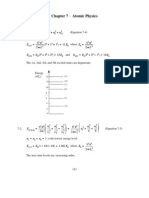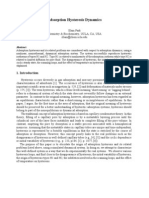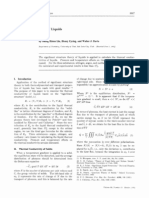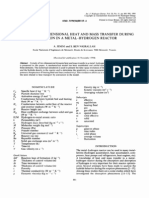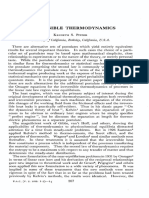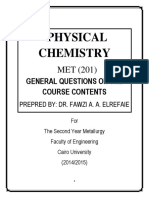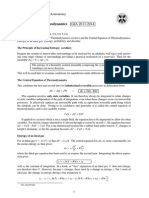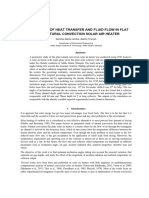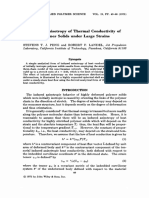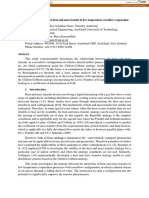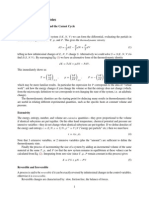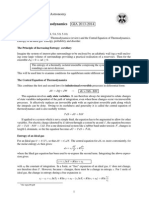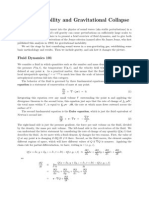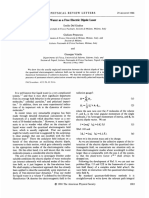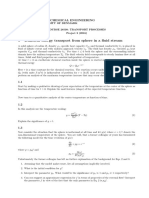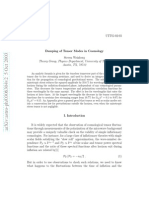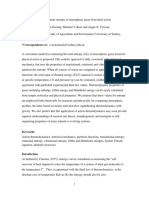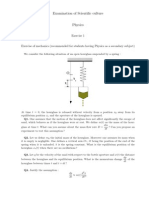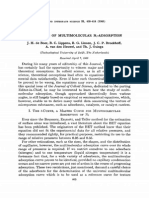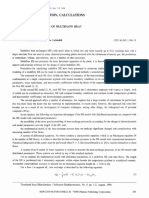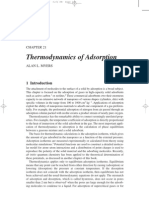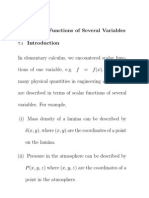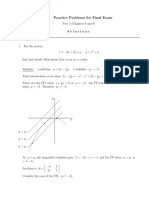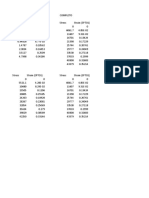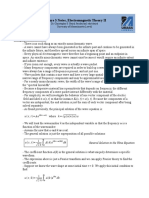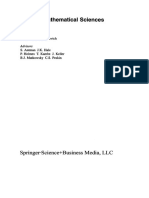Professional Documents
Culture Documents
Quarterly of Applied Mathematics: T, - For Such
Quarterly of Applied Mathematics: T, - For Such
Uploaded by
SuriyunOriginal Description:
Original Title
Copyright
Available Formats
Share this document
Did you find this document useful?
Is this content inappropriate?
Report this DocumentCopyright:
Available Formats
Quarterly of Applied Mathematics: T, - For Such
Quarterly of Applied Mathematics: T, - For Such
Uploaded by
SuriyunCopyright:
Available Formats
323
QUARTERLY
Vol. XXXIV
OF
APPLIED
JANUARY 1977
MATHEMATICS
No.
4
VARIATIONAL THERMODYNAMICS OF VISCOUS COMPRESSIBLE HEAT-CONDUCTING FLUIDS*
BY
M. A. BIOT Royal Academy of Belgium, Brussela
Abstract. A new variational principle of virtual dissipation generalizing dAlemberts principle to nonlinear irreversible thermodynamics is applied to compressible heatconducting fluids with Newtonian and non-Newtonian viscosity. The principle is applied in the context of Eulerian formalism where the flow is described with reference to a fixed coordinate system. New concepts of entropy displacement and mass displacement are used as well as a new definition of the chemical potential which avoids the usual ambiguities of the classical thermodynamic approach. The variational principle is used to derive a novel, form of field differential equations for the coupled fluid dynamics and convective heat transfer. principle which we have referred to as the has been shown to govern dissipative thermodynamic systems both linear and nonlinear [ 11.It was applied to a new fundamental approach to the thermorheology of continua including Newtonian and non-Newtonian viscous, compressible, heat-conducting fluids [2]. However, the treatment was based on a material description where the coordinates of the fluid particle fi are considered as functions of their initial coordinates xi :
principle of virtual dissipation of wide generality
Ei = $i(xk 7 Q* (1)
1. Introduction.
A new variational
In such a material description the density p per unit initial volume depends on the initial coordinates xi , so that the treatment is applicable to a fluid which is nonhomogeneous at rest. In the present treatment we shall consider a fluid which is homogeneous at rest with a uniform value of the density pO, the pressure p, and the temperature T, . For such a case it is possible to express the principle of virtual dissipation in Eulerian form, where the space coordinates & and the time are the independent variables.
2, 1975. Thii research was sponsored by the Air Force Office of Scientific Research through the European Office of Aerospace Research and Development AFSC, Uniled States Air Force, wder contract F 44620-71-C-0092. (N.A.M.)
* Received June
324
M. A. BIOT
The unknowns are now new variables Si & , t) and Mi(& , t) introduced below ((23), (24)) and representing fields of entropy and mass displacements. New definitions are obtained for the chemical potential and the fluid pressure which avoid the usual ambiguities of the classical treatment. Field differential equations in novel form are derived from the variational principle for the coupled dynamics and convective heat transfer. This is in contrast to current
procedures of deriving variational principles from the di$erential equations.
2. Principle of virtual dissipation in Eulerian form. ciple of virtual dissipation is expressed by
n
In its Eulerian form the prin-
J (6x6 n
fii
6Ui + pai
hi
&s*)
da = 0
(2)
where the integration is over a domain Q of space defined by the fixed coordinates & with the element of volume dL? = d& d& d& and no variations at the boundary. At a given time t and at the fixed point z$i, @i is the body force, p the fluid density, T the absolute temperature and 6ui a virtual material displacement. Per unit volume at point 5; and time t, 6 is the cell potential as defined previously ([l, 21) and s* is the entropy produced. The symbol 8R denotes a restricted variation for which 6.9 = 0. With the velocity ai the fluid acceleration is
It should be noted that, in contrast with the previous treatment, the unit element is not a material cell but a fised cell of unit dimension in space with matter flowing through its boundaries. From the viewpoint of thermodynamics it is an open cell. In order to formulate explicitly the variational principle in its Eulerian form we must introduce the concepts of mass and entropy displacement as well as a new approach to the definition of chemical potential which avoids some of the difficulties and ambiguities involved in classical thermodynanics. 3. Chemical potential volume may be written and entropy displacement. 6 = p6 where 5 = iz - T,s and where s, ti and s are respectively the cell potential, entropy per unit mass. The variation is 66 = s 6p + p ss. According to a previous result ([l, 21) we write (5) the internal energy, and the
(6)
The cell potential
of the unit (4)
where p is the fluid pressure as a known function of p and s under static conditions. Note
VARIATIONAL
THERMODYNAMICS
325
that this definition is purely thermodynamic and does not involve the viscous stresses, while 0 = T - T, is the excess temperature over the initial equilibrium temperature T, . Combining (5), (6) and (7) yields 66 = /l lip + e 6s where S = pS is the entropy per unit volume and p&Ts+; (9)
(8)
is the chemical potential which is a known function p(pS) of p and S. It is completely defined and does not contain any arbitrary constant since it is assumed that G = s = 0 in the initial equilibrium state. From (8) we derive aSlap = P,
as/se= s,
00)
thus providing a new definition of P. We shall also need the concept of entropy displacement already introduced earlier in a more restricted form [3]. Consider the material time derivative of s multiplied by p:
Taking into account the conservation
of mass condition
(12)
(11) becomes (13) On the other hand, the same material derivative times p may be written
Pz=
DS
-;rjjy+S
1 aJ,
.*_a-
z2
ati 0T
$5 Ji
a:
Se*
(14)
where Ji is the rate of heat flow by conduction per unit area and S,* is the rate of entropy production per unit volume due to viscosity, Equating expressions (13) and (14) yields (15) We define the entropy displacement
vector as
8; = A!!$ Sir + where the time derivatives & = pv,.?, are respectively Furthermore, the rates of entropy
6s = Ji/T
(16)
(17) and conduction.
displacements
by convection
326
M. A. BIOT
is the rate of entropy production per unit volume due to thermal conduction. integrating (15) with respect to time with zero initial conditions, we obtain
Hence,
(19)
where a* =
ST * + s.* (20)
is the total entropy produced per unit volume. Eq. (19) may be considered as an entropy conservation equation in terms of the entropy S per unit volume and the total entropy displacement field Si . The term s =
-as,/af,
(21)
will be called the entropy supplied per unit volume. Relation (21) constitutes a fundamental holomonic conservation constraint between s and Xi . We may also write (19) as s = s + s*, i.e. the total entropy of the unit volume is the sum of the entropy entropy supplied by convection and conduction. (22) produced and the
The field will be defined by seven 4. Variational derivation of the field equations. variables. Six of the variables are represented by two vectors, one being the entropy
displacement
Si = Si(f!s 7 t);
(23)
the other is the mass displacement
Mi = M&k )0 (24)
defined by the relation iPj = pvi . It satisfies the mass conservation equation (12) which may be written p = (25)
-aMi/ati
(26)
The seventh variable is the scalar s* representing the entropy produced per unit volume. When applying the variational principle (2) we vary the vectors Si and Mi . The various terms in the integrand of (2) are obtained as follows. Accoridng to (8) and (22) we write 66 = /.J6p + e 66 = p 6p + e qs + s*>. In order to obtain the restricted variation LiR put 6s* = 0. Hence we
(28)
(27)
6B6 = /.l 6p + 0 6s. The virtual displacemrnt 6ui of a fluid particle may be written 6ui = 6MJp.
(2%
VARIATIONAL
THERMODYNAMICS
327
The thermal conduction of the fluid is expressed by
Ji = TSiT = -lc(aO/a&) t
(30)
where k is the thermal conductivity
of the fluid at point & and time t. Hence (18) becomes
*= ST ;
A!$&.
p
The thermal conductivity
lc is a function of the local density
k = lc(p, S).
and local entropy
S:
(32)
The virtual dissipation due to thermal conduction is
T Gig.* = ; & 6SiT.
(33)
The virtual dissipation due to viscosity is (34) where vii is the viscous stress dependent on the strain rate tensor ei,. For a Newtonian fluid gii may be expressed as gii = aDo./aeii where the dissipation function is CO,= $(Xe + 2veiieji) (36) (35)
with viscosity coefficients Xand q and the volumetric strain rate e = e;i . The viscosity coefficients are functions of the local density p and local entropy S:
X = X(p, S), 71 = dP, S).
(37)
The strain rate is (33) For a non-Newtonian fluid we have shown by a very simple derivation that the viscous stress is expressed by
(39)
where F, = I
I
F~(P, s, I,, Ia I,>,
(40)
are functions of
p, S
and the three invariants I, = eiieii, I, = C?iieikeki. (41)
I, = eii 6ij ,
The total virtual dissipation is
T
,js* =
T(6sT*
&s,*) = ;
& GsiT + uii
-$
I
(42)
328
&I. A.
BIOT
With expressions (28) (29) and (42) for the variations, the variational principle (2) becomes
p S[
n
6p + fl 6s -
(~33~ aJ 6M, + E siT 6SiT + (Tii * -
ati
= 0. )Idn
(43)
1.
An essential step is due to the relations (44) derived from the holonomic conservation constraints (21) and (26). We introduce these values in the integrand of Eq. (43) and assume arbitrary variations 6Mi and SSi different from zero inside CLIntegration by parts then yields
s[(
n
ati
&i _ 1 au,,
P a.5
EL + ai
>
SMi + $$ 6Si + F & I
6SiT
dQ = 0.
(45)
It remains to evaluate KS, in terms of 6M< and SSi . Eq. (17),
sic= pvis
implies
sit&
(46)
SS, = s 6M, . Hence from Eq. (16) we obtain 6SjT = SSi s 6M, .
(47)
(48)
Introducing the values (47) and (48) into (45), we obtain
sR
n
ap 1 au..' zg/---~-~;+~i+S~)6M,+(~+~ST)6Si]d~. P ati
(49)
The variations 6M, and 6Si being arbitrary and independent, this result implies the field equations
(50)
These equations may be further transformed as follows. From Eqs. (5) and (9) we derive dp = d: + d ; 0 d(fE). (51)
Introducing the value (7) of s, we obtain dp = dr, - B do.
P
(52)
Hence
I
ap lap -=----s-s
ab
ae
P a.5
ati
(53)
VARIATIONAL
THERMODYNAMICS
329
Furthermore,
from (48) we write
SiT = & - &j
By substituting the values (53) and (54) the field equations (50) become
(54)
Is%.!
P a.&
auii ati >
,
(Bi + aj = 0,
(55)
0.
kg
T(S, - Sil!li) =
These six equations contain the seven unknowns t&M, and .a*. The additional equation may be obtained from (42) and expresses the local dissipation
~~* =
5 (Sj -
S~j)($j - gj@) +
gii
$ 7 .
(2
(56)
The acceleration ai is expreseed by means of (3) with vi = tii/p, while p is given by (26) and p, k, T and 8 are known functions of p and S. The field equations (55) provide a novel form governing the coupled dynamics and convective heat transfer of a viscous compressible heat conducting fluid for Newtonian as well as non-Newtonian viscosity. The corresponding variational principle is expressed by Eq. (2). This generalizes the variational principle obtained earlier [4, 5, 61 for uncoupled convective heat transfer.
REFERENCES [l] M. A. Biot, A virtual dissipation principle and Lagrangian equations in nonlinear irreversiblethermudynamics, Bull. Roy. Acad. Belgium 5th Ser., 61, 5-30 (1975) [2] M. A. Biot, VariationaLLagrangian irreversible thermodynamics of nonlinear thermorheology, Quart.
Appl. Math. (in press) [3] M. A. Biot, Thermoelasticity and irreversible thermodynamics, J. Appl. Phys. 27, 240-253 (1956) [4] M. A. Biot,, Lagrangian thermodynamics of heat transfer in systems including&id motion, J. Aerospace Sci. 29, 568-577 (1962) [5] M. A. Biot, Generalized variational principles for convective heat transfer and irreversible thermodynamics, J. Math. Mech. 15, 177-186 (1966) [SJ M. A. 13iol, Variational principles in heat transfer, Oxford Univ. Press, 1970
You might also like
- Chapter 7 Solutions Modern Physics 4th EditionDocument32 pagesChapter 7 Solutions Modern Physics 4th EditionhabanerochildNo ratings yet
- OriginalDocument3 pagesOriginalRaagaraja0% (1)
- Ec961 Preparation MaterialDocument27 pagesEc961 Preparation MaterialSapphasak Bun ChatchawanNo ratings yet
- Adsorption Hysteresis DynamicsDocument8 pagesAdsorption Hysteresis DynamicsMagdalena GrześkowiakNo ratings yet
- Assmt 1Document2 pagesAssmt 1Jz NeilNo ratings yet
- Thermal Of: Condilnctivity LiquidsDocument4 pagesThermal Of: Condilnctivity LiquidsER Gaurav BathlaNo ratings yet
- Liu90 On - Fouriers.lawDocument6 pagesLiu90 On - Fouriers.lawABDUL MUJIB LASKARNo ratings yet
- Transient Thermo-Elastic Waves in A Half-Space With Thermal Relaxation 1)Document19 pagesTransient Thermo-Elastic Waves in A Half-Space With Thermal Relaxation 1)deepakmitrNo ratings yet
- Study of Two-Dimensional Heat and Mass Transfer During PDFDocument11 pagesStudy of Two-Dimensional Heat and Mass Transfer During PDFali105No ratings yet
- Isentropic Expansion of Condensing SteamDocument9 pagesIsentropic Expansion of Condensing SteamHoustonAbducteeNo ratings yet
- 10.1351 Pac196102010207Document4 pages10.1351 Pac196102010207Vladimiro LelliNo ratings yet
- Irreversible Thermodynamics Kenneth PitzerDocument4 pagesIrreversible Thermodynamics Kenneth PitzerrolloNo ratings yet
- Lucia 1995 ThermodynamicsDocument9 pagesLucia 1995 ThermodynamicsJhann ReyesNo ratings yet
- Physical Cehmistry QuestionsDocument45 pagesPhysical Cehmistry Questionsيوسف عادل حسانينNo ratings yet
- School of Physics and Astronomy: File Topic09 PDFDocument4 pagesSchool of Physics and Astronomy: File Topic09 PDFzjnsrbtNo ratings yet
- Entropia y EnergiaDocument10 pagesEntropia y EnergiaalexNo ratings yet
- Activity Coefficient Models Describe EVL Binay Systems Ionic LiquidsDocument14 pagesActivity Coefficient Models Describe EVL Binay Systems Ionic LiquidsJulian VargasNo ratings yet
- Practical Applications of OdesDocument14 pagesPractical Applications of OdesMarvin kakindaNo ratings yet
- SolarsDocument11 pagesSolars11751175No ratings yet
- Unit - I Concept of Compressible Flow - Sae1301Document172 pagesUnit - I Concept of Compressible Flow - Sae1301Divy KaravdiyaNo ratings yet
- Induced Anisotropy of Thermal Conductivity Polymer Solids Under StrainsDocument20 pagesInduced Anisotropy of Thermal Conductivity Polymer Solids Under StrainsOlga ĆalasanNo ratings yet
- Natural and Forced Convection ExperimentsDocument12 pagesNatural and Forced Convection ExperimentsOmar Yamil Sanchez Torres25% (4)
- Transport Processes in Thin Liquid Films During High-Vacuum DistillationDocument9 pagesTransport Processes in Thin Liquid Films During High-Vacuum DistillationmahsaNo ratings yet
- Eringen1972 PDFDocument17 pagesEringen1972 PDFKamran MostajiriNo ratings yet
- The Analogy Between Heat and Mass Transfer in Low Temperature Crossflow EvaporationDocument11 pagesThe Analogy Between Heat and Mass Transfer in Low Temperature Crossflow EvaporationPIZZA MOZZARELLANo ratings yet
- Physics 127a: Class Notes: Lecture 5: Energy, Heat and The Carnot CycleDocument4 pagesPhysics 127a: Class Notes: Lecture 5: Energy, Heat and The Carnot CyclezhwNo ratings yet
- Theoretical Study of Heat and Mass Transfer in A Zeolite BedDocument11 pagesTheoretical Study of Heat and Mass Transfer in A Zeolite Bedali105No ratings yet
- School of Physics and Astronomy: File Topic09 PDFDocument5 pagesSchool of Physics and Astronomy: File Topic09 PDFBabu AravindNo ratings yet
- LS89 LesDocument16 pagesLS89 Lesmustafasanli2000No ratings yet
- School of Physics and Astronomy Junior Honours Thermodynamics GJA 2013-2014Document4 pagesSchool of Physics and Astronomy Junior Honours Thermodynamics GJA 2013-2014Babu AravindNo ratings yet
- Thermodynamics and Cosmology 1: I. Prigogine, 2'3 J. Geheniau, 3 E. Gunzig, 3 and P. Nardone 3Document10 pagesThermodynamics and Cosmology 1: I. Prigogine, 2'3 J. Geheniau, 3 E. Gunzig, 3 and P. Nardone 3Juan Pablo Ramirez MonsalveNo ratings yet
- Jeans InstabilityDocument6 pagesJeans InstabilityClaudio Cofré MansillaNo ratings yet
- IsentropicDocument42 pagesIsentropicDeepak JayNo ratings yet
- oto Ato' H (T - T°) +koa To - : (Received June in Revised Form January Received MarchDocument6 pagesoto Ato' H (T - T°) +koa To - : (Received June in Revised Form January Received Marchcpgcha57No ratings yet
- The Thermal Inertia Characteristics of The System Ocean-AtmosphereDocument4 pagesThe Thermal Inertia Characteristics of The System Ocean-AtmosphereedgarjoNo ratings yet
- Entropy: Carnot-Like Heat Engines Versus Low-Dissipation ModelsDocument13 pagesEntropy: Carnot-Like Heat Engines Versus Low-Dissipation ModelsPudretexDNo ratings yet
- Entropy I PDFDocument19 pagesEntropy I PDFsNo ratings yet
- Del Giudice, Emilio Preparata, Giuliano Vitiello, Giuseppe - Water As A Free Electric Dipole Laser PDFDocument4 pagesDel Giudice, Emilio Preparata, Giuliano Vitiello, Giuseppe - Water As A Free Electric Dipole Laser PDFЮрий ЮрийNo ratings yet
- Simulation of G R A N U L A R Layer Inversion in Liquid Fluidized BedsDocument9 pagesSimulation of G R A N U L A R Layer Inversion in Liquid Fluidized BedsAlmir Guilherme RittaNo ratings yet
- The Law of Rectilinear Diameter For The Liquid Gas Phase TransitionDocument3 pagesThe Law of Rectilinear Diameter For The Liquid Gas Phase Transitionagarwalashwin32No ratings yet
- On The Validity of The Boussinesq Approximation in A Tall Differentially Heated Cavity With WaterDocument7 pagesOn The Validity of The Boussinesq Approximation in A Tall Differentially Heated Cavity With WatercrazzyrajNo ratings yet
- BPHCT 135Document19 pagesBPHCT 135jerry tomNo ratings yet
- SPE-119200-PA (Thermal Streamline Simulation For Hot Waterflooding)Document11 pagesSPE-119200-PA (Thermal Streamline Simulation For Hot Waterflooding)Amr Al SayedNo ratings yet
- Steam Reformer: Created in COMSOL Multiphysics 5.4Document30 pagesSteam Reformer: Created in COMSOL Multiphysics 5.4Rizky KusumastutiNo ratings yet
- Transport Process ProjectDocument2 pagesTransport Process ProjectWael ShammoutNo ratings yet
- Simulating Coupled Heat Transfer and Fluid Flow in Comsol: AC 274 Tutorial (Fall 2017)Document14 pagesSimulating Coupled Heat Transfer and Fluid Flow in Comsol: AC 274 Tutorial (Fall 2017)Brandeice BarrettNo ratings yet
- S N 1 T NDocument14 pagesS N 1 T NsatyabashaNo ratings yet
- Compressible Turbulent Flow Numerical Simulations of Tip Vortex CavitationDocument5 pagesCompressible Turbulent Flow Numerical Simulations of Tip Vortex CavitationQianZHNo ratings yet
- Correspondence To: Ivan - Kennedy@sydney - Edu.au: T) Required To Sustain A Chemical SystemDocument42 pagesCorrespondence To: Ivan - Kennedy@sydney - Edu.au: T) Required To Sustain A Chemical SystemabcdefNo ratings yet
- Sujets Physique SIS09 enDocument6 pagesSujets Physique SIS09 enKlevis KasoNo ratings yet
- Combustion and Flame PaperDocument17 pagesCombustion and Flame PaperHaematomaNo ratings yet
- Tutorial Virial ExpansionDocument16 pagesTutorial Virial Expansion87871547No ratings yet
- Enkog Castillo1990Document12 pagesEnkog Castillo1990Mikhail TarabrinNo ratings yet
- AdvHeatMass L 04 PDFDocument8 pagesAdvHeatMass L 04 PDFShanmukShannuNo ratings yet
- Prediction of Vapor-Liquid Equilibrium Data of Binary SystemsDocument3 pagesPrediction of Vapor-Liquid Equilibrium Data of Binary SystemsRené Mora-CasalNo ratings yet
- Metodo de Boer OriginalDocument10 pagesMetodo de Boer OriginalCarlos TimanaNo ratings yet
- Exact Solution For Heat Conduction Problem of A Hollow Circular MembraneDocument6 pagesExact Solution For Heat Conduction Problem of A Hollow Circular MembraneAmirhosein MiranNo ratings yet
- Methods For The Design of Multiflow Heat ExchangesDocument3 pagesMethods For The Design of Multiflow Heat ExchangesИгорь МаксимовNo ratings yet
- Thermodynamics of AdsorptionDocument13 pagesThermodynamics of Adsorptionapi-3709413100% (1)
- Energies 12 03266Document14 pagesEnergies 12 03266BillyNo ratings yet
- Treatise on Irreversible and Statistical Thermodynamics: An Introduction to Nonclassical ThermodynamicsFrom EverandTreatise on Irreversible and Statistical Thermodynamics: An Introduction to Nonclassical ThermodynamicsRating: 1 out of 5 stars1/5 (1)
- Quantum Physics For Beginners PDFDocument11 pagesQuantum Physics For Beginners PDFScribdTranslationsNo ratings yet
- Physics A+ TestDocument3 pagesPhysics A+ TestMirza Umar Farooq BaigNo ratings yet
- 2015 Reith Lecture Hawking Ep1Document7 pages2015 Reith Lecture Hawking Ep1gorda1997100% (1)
- Flory Huggins Theory: Polymer Chemistry AssignmentDocument11 pagesFlory Huggins Theory: Polymer Chemistry AssignmentShivani Upadhyay100% (1)
- Atomic and Molecular Spectroscopy Lecture 2Document29 pagesAtomic and Molecular Spectroscopy Lecture 2Hammed LawalNo ratings yet
- APhO2001 Theory Prob 2Document2 pagesAPhO2001 Theory Prob 2Popovici DraganNo ratings yet
- Puntos de EdpDocument3 pagesPuntos de EdpPetter LovedNo ratings yet
- Symmetrically Loaded Shells of Revolution in Membrane TheoryDocument17 pagesSymmetrically Loaded Shells of Revolution in Membrane TheoryAnca BirisNo ratings yet
- SyllabusDocument2 pagesSyllabusFriche BagsNo ratings yet
- The Coefficent of Restitution, Momentum & Impulse, Mechanics Revision Notes From A-Level Maths TutorDocument5 pagesThe Coefficent of Restitution, Momentum & Impulse, Mechanics Revision Notes From A-Level Maths TutorA-level Maths Tutor100% (1)
- Electronic Structure of Atoms: Guia Emary Enero Sherlyn Verdeflor Eric Duma-Og John Mark Jabagaton Junie LaurenteDocument52 pagesElectronic Structure of Atoms: Guia Emary Enero Sherlyn Verdeflor Eric Duma-Og John Mark Jabagaton Junie LaurenteGuia Emary EneroNo ratings yet
- Motion or MovementDocument2 pagesMotion or MovementSariah DiezNo ratings yet
- Rohit SAQ's PhysicsDocument5 pagesRohit SAQ's Physicsmallajasmitha7No ratings yet
- Ramirez-Riberos Et AlDocument15 pagesRamirez-Riberos Et AlcelticpenguinNo ratings yet
- NUS - MA1505 (2012) - Chapter 7Document42 pagesNUS - MA1505 (2012) - Chapter 7Gilbert SebastianoNo ratings yet
- Laplace's Equation in The Polar Coordinate SystemDocument3 pagesLaplace's Equation in The Polar Coordinate SystemAlagbaDejiNo ratings yet
- Manikas A. - Differential Geometry in Array Processing-ICP (2004)Document231 pagesManikas A. - Differential Geometry in Array Processing-ICP (2004)Ibrahim OuanzarNo ratings yet
- History of The Atom - With TimelineDocument11 pagesHistory of The Atom - With TimelineDana May Bisares FeriaNo ratings yet
- WPH14 - 01 - Que - Jan 2020Document28 pagesWPH14 - 01 - Que - Jan 2020adadsadNo ratings yet
- 1476853244-UG PhysicsDocument26 pages1476853244-UG PhysicsS.M. Ashikur RahmanNo ratings yet
- Practice Problems For Final ExamDocument5 pagesPractice Problems For Final ExamkrishnaNo ratings yet
- Detlef Dürr, Dustin Lazarovici - Understanding Quantum Mechanics - The World According To Modern Quantum Foundations (2020, Springer)Document247 pagesDetlef Dürr, Dustin Lazarovici - Understanding Quantum Mechanics - The World According To Modern Quantum Foundations (2020, Springer)saraNo ratings yet
- Resultados Tensión AnsysDocument4 pagesResultados Tensión AnsysAndres VegaNo ratings yet
- SCHR Odinger Equation, One-Dimensional ProblemsDocument1 pageSCHR Odinger Equation, One-Dimensional Problemscamelrider123No ratings yet
- Electric Potential-IIDocument26 pagesElectric Potential-IISumaya Akter Ruhi 2022610642No ratings yet
- Lecture 3 Notes, Electromagnetic Theory II: 1. Superposition of WavesDocument7 pagesLecture 3 Notes, Electromagnetic Theory II: 1. Superposition of Waves*83*22*No ratings yet
- Applied Mathematical Sciences Peter J. Schmid, Dan S. Henningson (Auth.-Stability and Transition in Shear FlowsDocument560 pagesApplied Mathematical Sciences Peter J. Schmid, Dan S. Henningson (Auth.-Stability and Transition in Shear Flowsgkmk555No ratings yet
